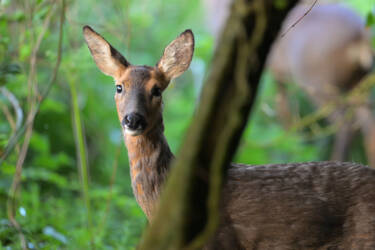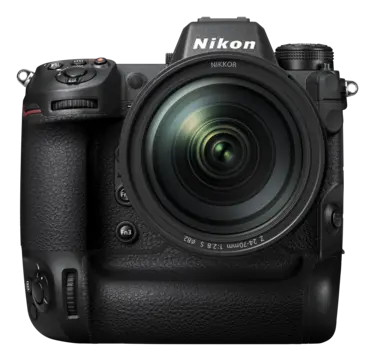How to film wildlife at home with Hannah Stitfall

BBC Springwatch presenter Hannah Stitfall on composition, filming on the Cornish coast and understanding animal behaviour
“It’s so important to tell the story of every single species, big to small, to encourage conservation,” enthuses Nikon Creator Hannah Stitfall. “Last night, a female tawny owl flew right above my head. This morning, I woke up to a blackbird singing out my window. What’s their story?”
Hannah’s career as a wildlife broadcaster, filmmaker, photographer and conservationist has taken her all over the world – from northern Sweden in the depths of winter (“It’s like a scene out of Narnia, babe,” she tells Nikon magazine) to the ruggedness of Zambia and everything in-between. “British wildlife is my bread and butter, though,” the BBC Earth, BBC The One Show and BBC Springwatch presenter explains. “Celebrating what’s on our doorstep is so important. Everything I film at home is within a three-mile radius of where I live in Cornwall because I don’t drive. I want to hook people into local wildlife so they become interested and passionate conservationists. I’m incredibly privileged to have worked across the world, but my top five wildlife experiences have been in Cornwall – down in a badger sett or fox den. These are the moments that stick with you and give you goose bumps.”
So, how does the storyteller film at home?
What’s in my kitbag?
All in the prep
“Understanding animal behaviour is key for the best composition,” Hannah explains. “Know how to find the animals and when they’re most active. In January, I set up 15 camera traps so I could watch them over spring – I know that most of the foxes come out at 8pm every night. Then, you’ve got to think: ‘What way are they going to move into shot? What are they eating? Are they breeding? Are they raising young? What kind of behaviours are you trying to photograph? Spend time with your subject matter, learn their calls – can you hear an alarm call? A breeding call? A territorial call? What will they do next? I’m filming 15 badgers at the moment and I know they’ve all got different personalities!”
Gather your gear
“When I’m at home, I’m on always on foot,” says Hannah. “To keep weight down, my gear is minimal: my workhorse Z9, the NIKKOR Z 180-600mm f/5.6-6.3 VR (DX equivalent 270-900mm), which is my lightweight zoom, and a most recent addition, the NIKKOR Z 400mm f/2.8 TC VR S. The f/2.8 aperture offers that extra time at dawn and dusk where the lowlight might otherwise make my footage grainy. I also have the Vanguard travel tripod, which holds the weight of the camera, though I often film handheld.”
Top tips: Beginners will want to start out with a zoom lens due to its variable focal length. Got a DX camera? Try the NIKKOR Z DX 50-250mm f/4.5-6.3 VR (equivalent to 75mm-375mm full-frame) or the NIKKOR Z 24-200mm f/4-6.3 VR for a full-frame equivalent of 36mm-300mm focal length (for an explanation on DX crop factor, click here). Meanwhile, the NIKKOR Z 100-400mm f/4.5-5.6 VR S offers the extra focal length reach of 400mm (600mm equivalent on DX). Don’t forget you can also add a teleconverter to double you focal length.
Know your settings
Hannah’s settings vary per situation, but these can be used as a base:
Frame rate and resolution: 4K and 120fps. “Filming in 120fps means I have the opportunity to slow down for cinematic slow motion in post-production. If I film in 120fps I have the option for cinematic and slow or normal, so it gives greater versatility – and often I post both versions on Instagram, so double the post with the same amount of work!”
Shutter speed: “Often 1/240 (to match 120fps) depending on the light, the animal and what I want to achieve.”
Focus mode: “AF-F for full time-time autofocus.”
White Balance: “Daylight or shady – I want to keep it as natural as possible!”
ISO: “I always aim to not to push too high to reduce graininess!”
Find your style
How would Hannah describe her style? “Immersive. I want the viewer to feel they’re in the moment – a lot of my followers don’t have access to wildlife as I do, like I always think about how I can make people feel as if they’re there with me. That’s why I often start my videos with me and my camera, then the cinematic video of the animal itself. I want people to have more moments with wildlife because that’s what makes them fall in love with it, not want to kill it.”
That also means keeping her editing low-key. “I hate editing!” she laughs. “I’m such a perfectionist. And, while I learned how to edit while doing my master’s in wildlife filmmaking, I love the colour straight from the camera. Colour grading and LUTS slow down my workflow – plus, a lot of my filming is very rough and ready. It’s me in a ghillie suit being eaten by mosquitoes and then going into the wildlife!”
Trial and error are key
“Just start by doing,” Hannah advises. “Learn as you go. I’m not very tech minded. I just know what works when I’m in the field. There is so much wildlife on our doorstep that you can really learn your craft, learn their behaviour, learn what looks good. It’s trial and error. See what looks good and what doesn’t. Be consistent, too, and aim to post three to four times a week on social media to build your portfolio.”
Keep up with the latest in Hannah Stitfall’s adventures here.
More in Nature and Wildlife
Featured products
Join the mirrorless revolution

Unlock greater creativity













